Matcha
Matcha and Acid Reflux: Yes or No?
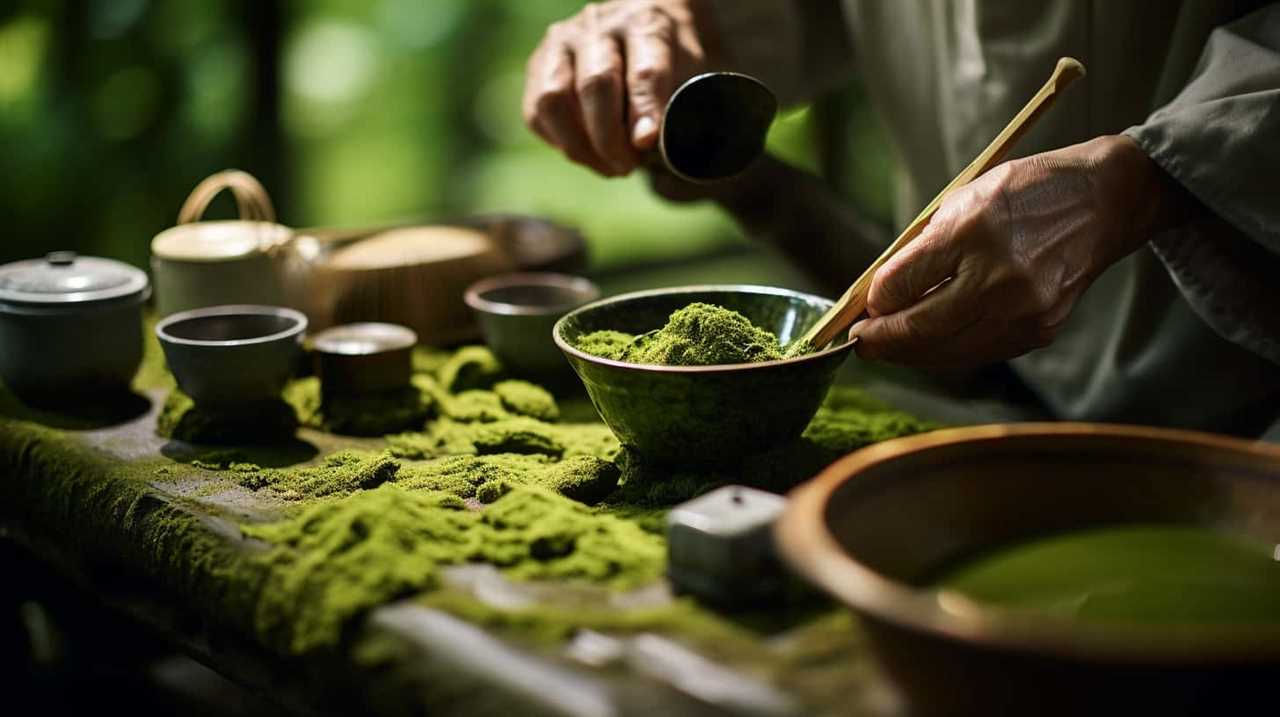
Are you wondering if matcha is bad for acid reflux? Well, here’s something you might not know: matcha, a powdered form of green tea, has gained popularity in recent years due to its numerous health benefits.
However, if you suffer from acid reflux, you may be concerned about its potential effects on your condition. In this article, we will explore whether matcha is a good choice for acid reflux sufferers or if it should be avoided.
We’ll dive into the components of matcha, its caffeine content, and expert opinions on the matter. By the end, you’ll have a clear understanding of whether matcha is a friend or foe in your battle against acid reflux.
Key Takeaways
- Matcha’s alkalizing properties can help neutralize stomach acid and alleviate acid reflux symptoms.
- Matcha’s catechins and L-theanine may support healthy digestion and reduce stress, contributing to a calmer digestive system.
- Matcha’s caffeine content and acidity may trigger or worsen acid reflux symptoms in some individuals.
- It is important to consider personal tolerance and consume matcha in moderation to avoid exacerbating acid reflux symptoms.
What Is Acid Reflux
Acid reflux is a common condition in which stomach acid flows back into the esophagus, causing discomfort and sometimes damage to the lining of the esophagus. It occurs when the lower esophageal sphincter (LES), the muscle that normally prevents stomach acid from flowing upward, becomes weak or relaxes inappropriately.
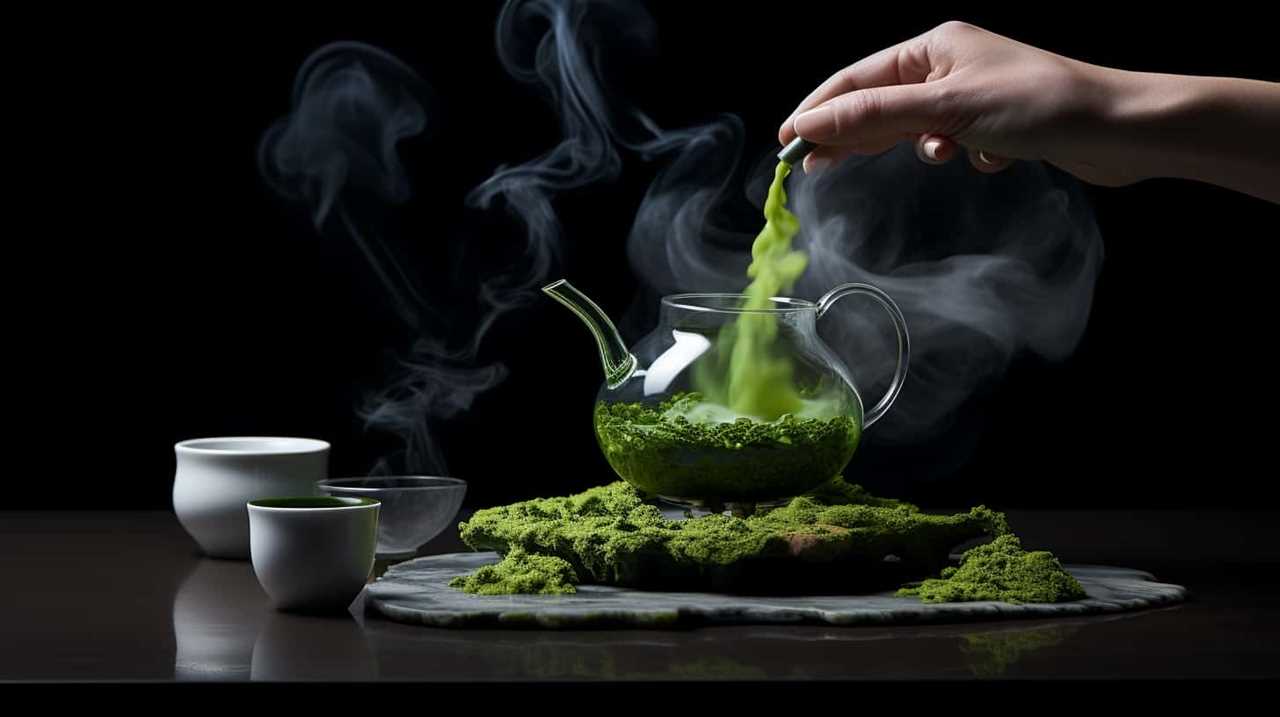
There are several factors that can contribute to the development of acid reflux. One of the main causes is a hiatal hernia, which occurs when the upper part of the stomach protrudes into the chest through the diaphragm. Other common causes include obesity, pregnancy, smoking, and certain medical conditions such as diabetes and asthma.
Fortunately, there are several effective treatments available for acid reflux. Lifestyle modifications, such as losing weight, avoiding trigger foods and beverages (such as spicy or fatty foods, caffeine, and alcohol), and eating smaller meals can help alleviate symptoms. Over-the-counter antacids can also provide temporary relief by neutralizing stomach acid. For more severe cases, proton pump inhibitors (PPIs) may be prescribed to reduce the production of stomach acid. In some cases, surgery may be necessary to strengthen the LES and prevent acid reflux.
Now that we have a better understanding of acid reflux and its causes and treatment options, let’s move on to the next section where we’ll discuss whether matcha is bad for acid reflux.
Understanding Matcha
Now let’s delve into the topic of matcha and its effects on acid reflux.
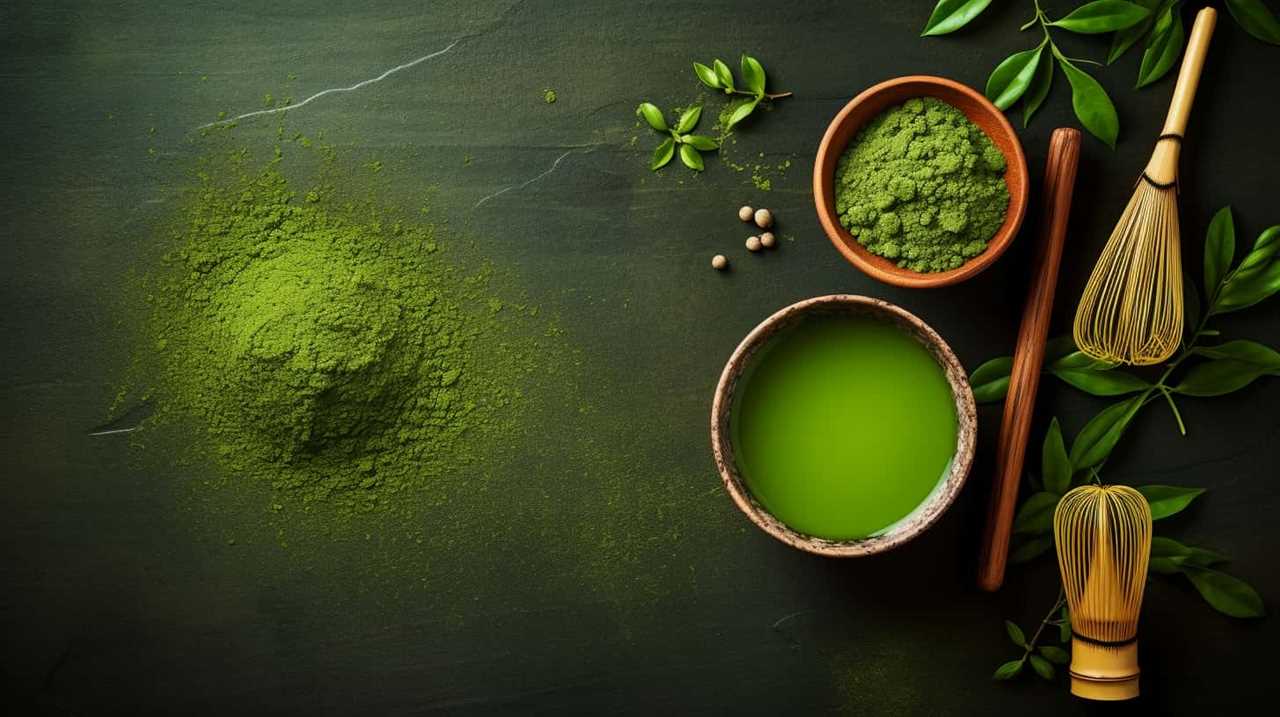
Matcha is a finely ground powder made from green tea leaves. It has gained popularity in recent years due to its unique flavor and potential health benefits.
Here are some key points to help you understand matcha:
- Matcha production: Matcha is made from shade-grown tea leaves, which are carefully handpicked and steamed to prevent oxidation. Afterward, the leaves are dried and ground into a fine powder. This process helps retain the nutrients and antioxidants present in the tea leaves.
- Antioxidant powerhouse: Matcha is known for its high concentration of antioxidants, especially catechins. These compounds have been linked to various health benefits, including reducing the risk of chronic diseases and promoting heart health.
- Boosts metabolism: Matcha contains a compound called EGCG (epigallocatechin gallate), which has been found to increase metabolism and support weight loss. However, it’s important to note that matcha alone isn’t a magic solution for weight loss. A balanced diet and regular exercise are still essential.
- Calming effects: Matcha contains an amino acid called L-theanine, which promotes relaxation and helps reduce stress. This can be beneficial for those who experience acid reflux triggered by anxiety or stress.
- Moderation is key: While matcha offers potential health benefits, it’s important to consume it in moderation. Excessive consumption may lead to digestive issues, including acid reflux. It’s best to consult with a healthcare professional to determine the appropriate amount for your individual needs.
Understanding matcha and its effects on acid reflux can help you make informed decisions about incorporating it into your diet. Remember to enjoy matcha as part of a balanced and varied diet, and always listen to your body’s cues.
Acid Reflux Symptoms
We often experience symptoms of acid reflux, such as heartburn and regurgitation, when stomach acid flows back up into the esophagus. These symptoms can be uncomfortable and disruptive to our daily lives. It’s important to understand the causes of acid reflux in order to find effective natural remedies.
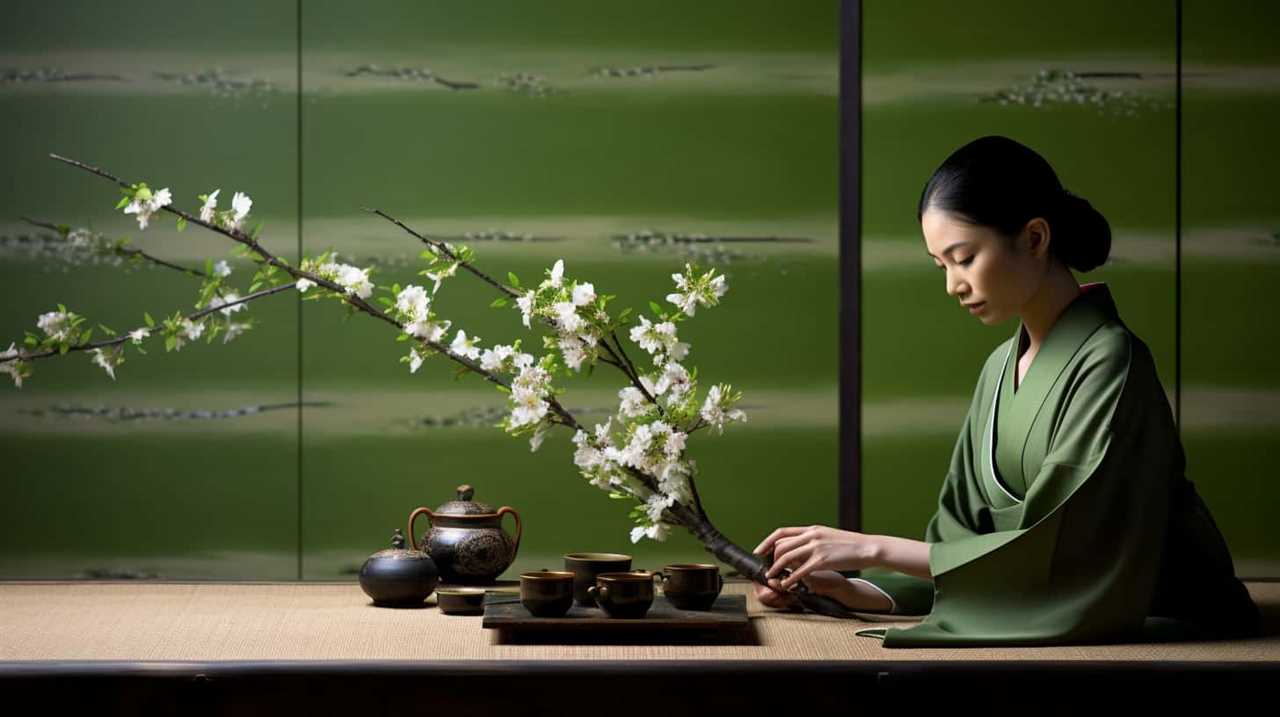
There are several common causes of acid reflux. One major factor is a weakened or relaxed lower esophageal sphincter (LES), the muscle that acts as a barrier between the stomach and the esophagus. Other contributing factors include obesity, smoking, certain foods and beverages, and certain medications.
Fortunately, there are natural remedies that can help alleviate the symptoms of acid reflux. One effective method is to make dietary changes. Avoiding trigger foods such as spicy and fatty foods, citrus fruits, tomatoes, and chocolate can help reduce acid reflux symptoms. Additionally, maintaining a healthy weight, quitting smoking, and avoiding large meals before bedtime can also be beneficial.
Incorporating lifestyle changes such as eating smaller, more frequent meals, elevating the head of the bed, and practicing stress-reducing techniques like meditation or yoga can also help manage acid reflux symptoms.
Components of Matcha
The components of matcha include its unique blend of antioxidants, amino acids, and caffeine. Understanding matcha components is essential in determining how matcha may affect digestion. Here are five key components of matcha and their potential impact on digestion:

- Antioxidants: Matcha is rich in antioxidants called catechins, which have been shown to have anti-inflammatory properties. These antioxidants may help reduce inflammation in the digestive system, potentially alleviating symptoms of digestive disorders.
- Amino Acids: Matcha contains an amino acid called L-theanine, which has been found to promote relaxation and reduce stress. Stress can contribute to digestive issues, so the presence of L-theanine in matcha may support healthy digestion.
- Caffeine: Matcha contains a moderate amount of caffeine, which can stimulate the production of stomach acid. While this may be problematic for individuals with acid reflux, it can also aid digestion by increasing gastric emptying.
- Fiber: Matcha is a good source of dietary fiber, which can promote regular bowel movements and support a healthy digestive system.
- Chlorophyll: Matcha’s vibrant green color comes from its high chlorophyll content. Chlorophyll has been found to have detoxifying properties and may support the body’s natural detoxification processes.
Caffeine Content in Matcha
When it comes to matcha and its impact on acid reflux, the caffeine content of matcha is an important factor to consider. Matcha contains a moderate amount of caffeine, which can potentially trigger acid reflux symptoms in some individuals.
However, it’s worth noting that matcha also contains an amino acid called L-theanine, which has been shown to have a calming effect on the body and may help mitigate the negative effects of caffeine.
Therefore, the caffeine content in matcha should be taken into account when evaluating its potential effects on acid reflux.
Matcha and Acidity
Regarding matcha and acidity, it’s important to consider the caffeine content in matcha. While matcha has numerous health benefits, its caffeine content can potentially impact acidity levels in the body.

Here are some key points to keep in mind:
- Matcha contains caffeine, which can stimulate the production of stomach acid.
- Excessive caffeine intake may lead to acid reflux symptoms such as heartburn and indigestion.
- However, matcha also contains L-theanine, an amino acid that can help reduce the negative effects of caffeine on the digestive system.
- The combination of caffeine and L-theanine in matcha may have a more balanced effect on gut health compared to other caffeinated beverages.
- It’s important to listen to your body and moderate your matcha consumption if you experience any discomfort.
Now, let’s explore the impact of matcha on digestion and how it can affect overall gut health.
Matcha Impact on Digestion
Our research indicates that the caffeine content in matcha can potentially affect digestion. Consuming matcha, which contains a significant amount of caffeine, may have an impact on the digestive system. Caffeine is known to stimulate the release of hydrochloric acid in the stomach, which can lead to an increase in gastric acid production. This can potentially cause issues such as heartburn, indigestion, and stomach discomfort.
However, it’s important to note that the impact of matcha on digestion may vary from person to person. Some individuals may experience these symptoms more severely than others. Additionally, matcha also contains beneficial compounds like catechins and antioxidants, which can provide potential benefits to digestion.
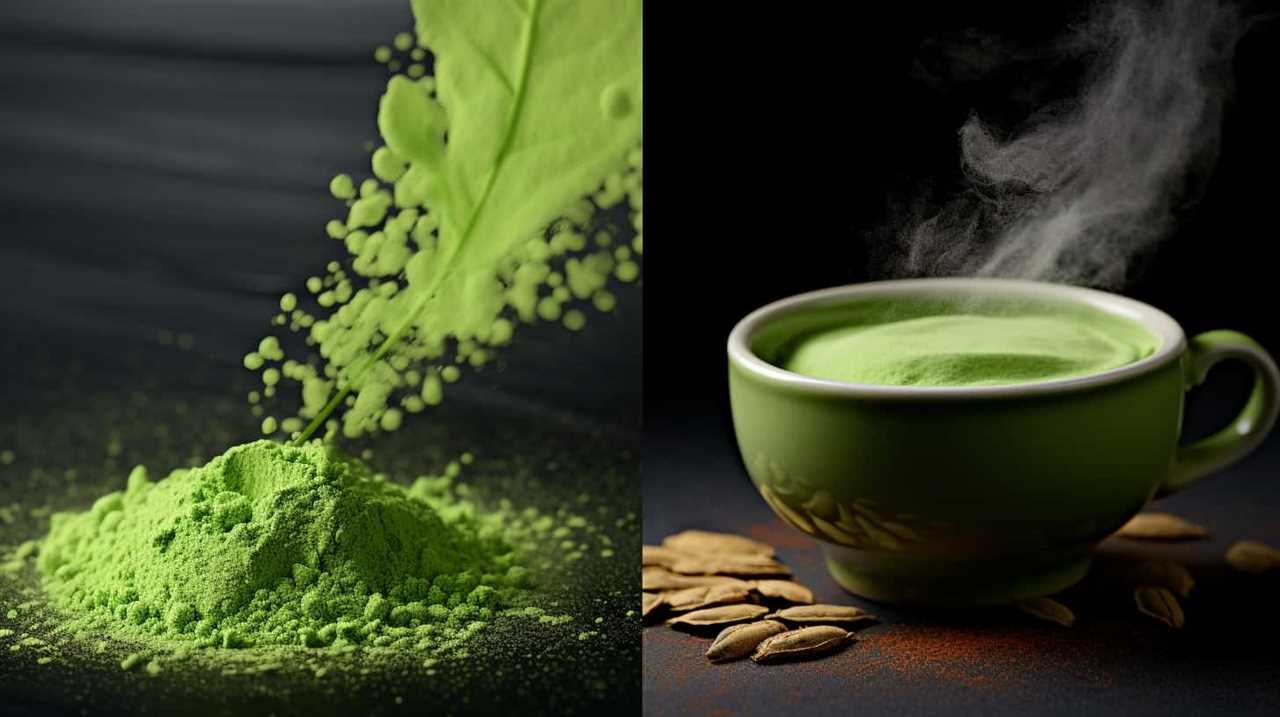
As with any food or beverage, it’s recommended to consume matcha in moderation and listen to your body’s response.
The Role of Acidity in Acid Reflux
When it comes to acid reflux, the role of acidity is crucial to understand. Acidic foods can trigger or worsen reflux symptoms, leading to discomfort and heartburn.
Managing acidity levels in our diet is important for preventing or reducing acid reflux. Maintaining a balanced pH level is key to keeping acid reflux in check.
Acidic Foods and Reflux
One possible first sentence for the subtopic could be: ‘We often wonder how acidic foods contribute to acid reflux.’
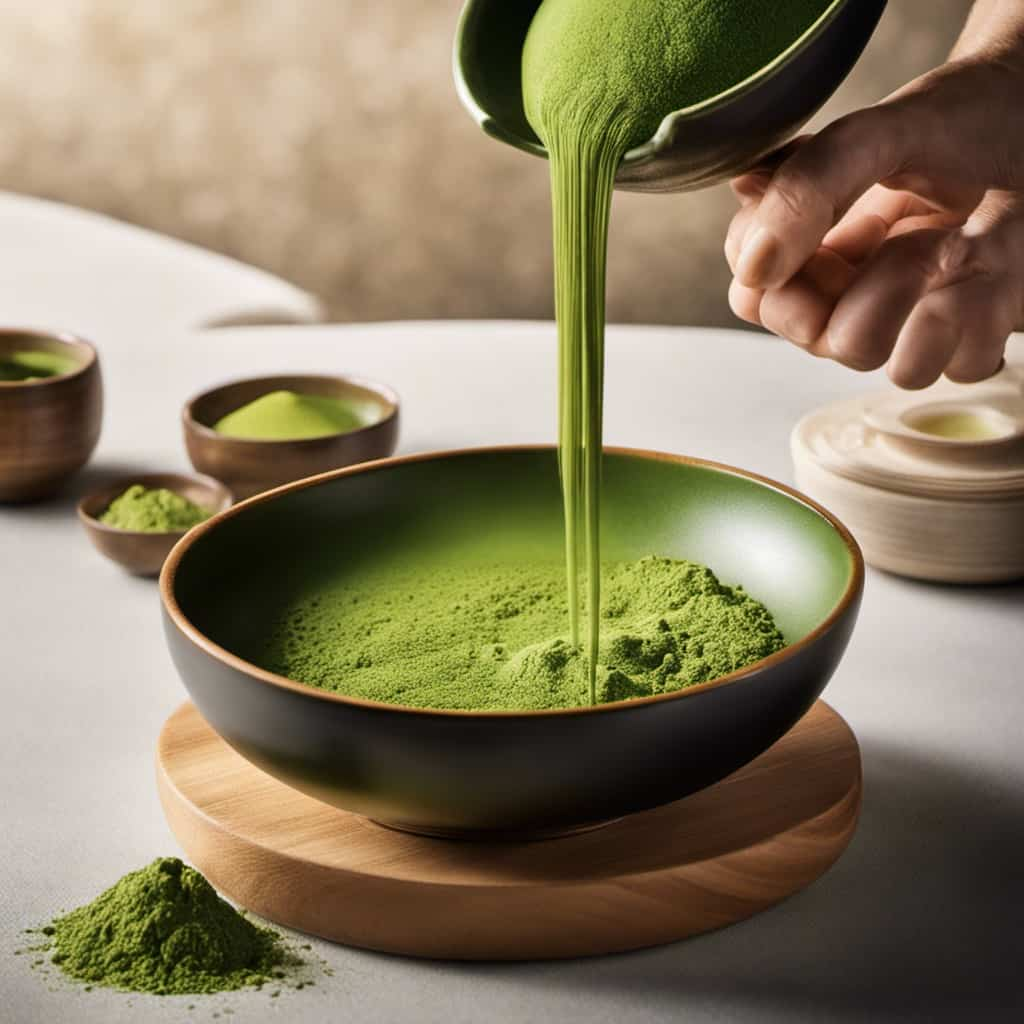
- Acidic foods can trigger acid reflux by irritating the lining of the esophagus and causing the stomach acid to flow back up.
- Citrus fruits, tomatoes, and vinegar-based foods are common acidic triggers for acid reflux.
- Spicy foods, such as peppers and hot sauces, can also increase acid production and exacerbate reflux symptoms.
- Carbonated drinks, like soda and sparkling water, are highly acidic and can weaken the lower esophageal sphincter, allowing stomach acid to escape.
- Coffee and alcohol are known to relax the esophageal sphincter, leading to increased acid reflux episodes.
It is important to note that while matcha is a slightly acidic beverage, it’s also rich in antioxidants and has been associated with various health benefits. However, individuals with acid reflux should monitor their intake and consider how it affects their symptoms.
Managing Acidity Levels
To effectively manage acid reflux, we must carefully consider the role of acidity in our diet. Proper management of acidity levels can help alleviate symptoms and prevent flare-ups.
While it’s important to avoid highly acidic foods and beverages that can trigger reflux, such as citrus fruits and tomatoes, some foods actually have alkalizing properties that can help neutralize stomach acid.
One such food is matcha, a type of powdered green tea. Matcha has been shown to have numerous health benefits, including its ability to reduce acidity in the body. It contains catechins, which have been found to have alkalizing effects.
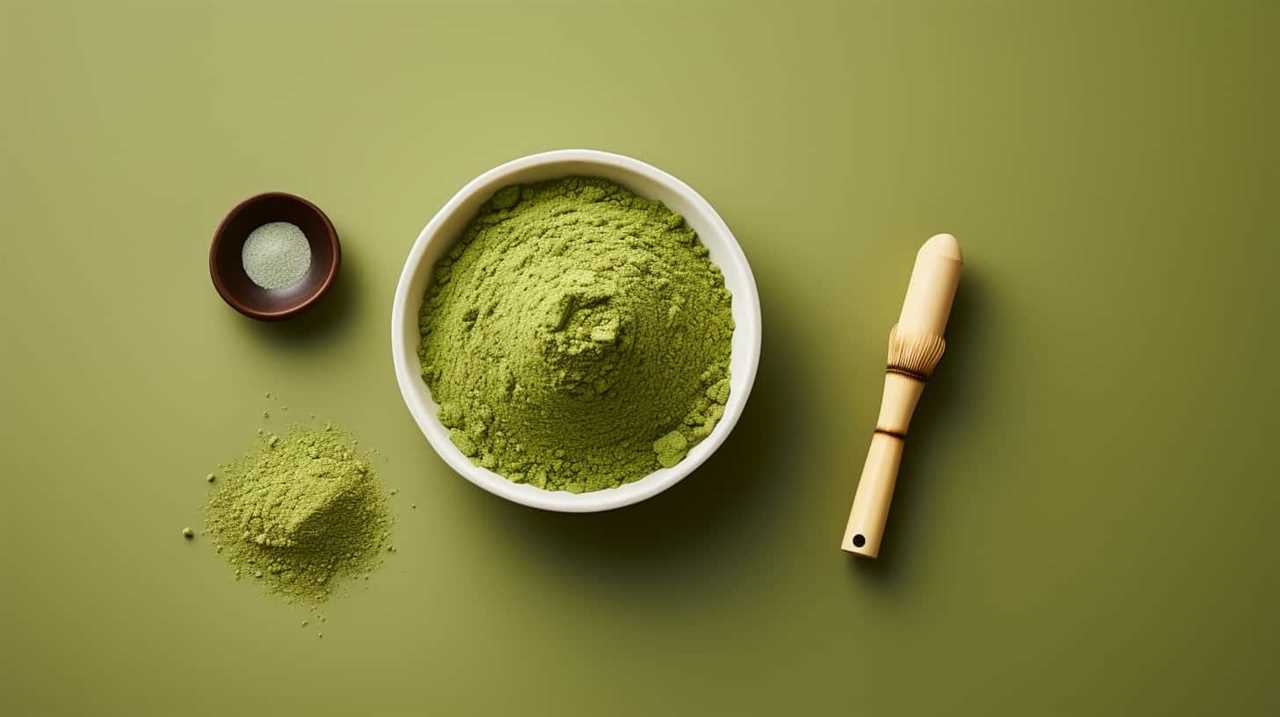
Incorporating matcha into your diet may help maintain a balanced pH level and reduce the risk of acid reflux.
Impact of Ph Balance
Acidity plays a crucial role in the development and symptoms of acid reflux. Maintaining the proper pH balance in our digestive system is essential for optimal gut health. Here are some key points to consider:
- pH balance and digestion: The acidity level in our stomach helps break down food and aids in digestion.
- Acid reflux: When the pH balance is disrupted, it can lead to acid reflux, causing heartburn and discomfort.
- Matcha and gut health: Matcha contains catechins, which have been found to promote a healthy gut environment.
- Alkalizing effect: Matcha has an alkalizing effect on the body, which may help restore pH balance and reduce acid reflux symptoms.
- Antioxidant properties: Matcha is rich in antioxidants, which can help reduce inflammation and protect the gut lining.
Understanding the impact of pH balance on acid reflux is crucial in exploring the potential effects of matcha.
Now, let’s dive into the research on matcha and acid reflux.
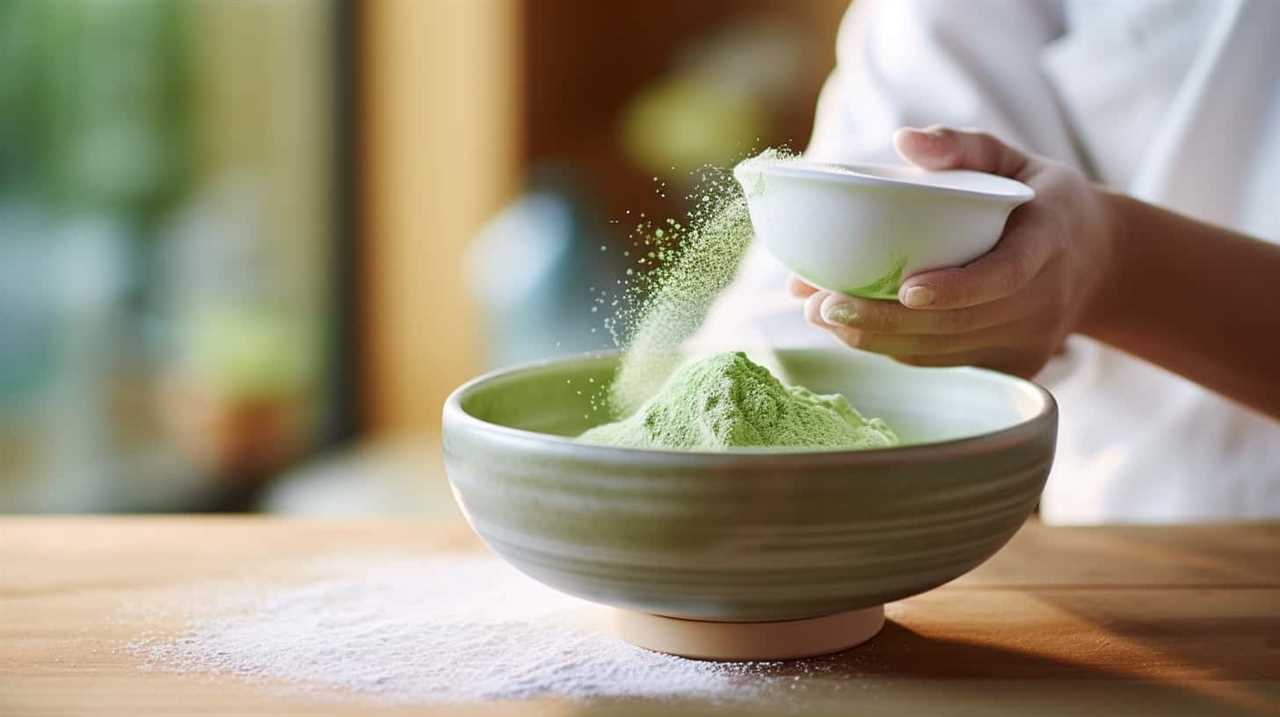
Research on Matcha and Acid Reflux
Although there’s limited research available, we’ve found some studies examining the effects of matcha on acid reflux. While there’s no direct research specifically investigating the impact of matcha on acid reflux, some studies suggest potential benefits and drawbacks.
One study published in the Journal of Gastroenterology and Hepatology found that green tea, which is similar to matcha, might have a protective effect against acid reflux. The study showed that green tea consumption was associated with a lower risk of developing gastroesophageal reflux disease (GERD), a condition characterized by acid reflux.
On the other hand, matcha contains caffeine, which can stimulate the production of stomach acid and potentially worsen symptoms of acid reflux. Additionally, matcha is high in catechins, a type of antioxidant, which may relax the lower esophageal sphincter (LES) and allow stomach acid to flow back into the esophagus.
Potential Benefits of Matcha for Acid Reflux
While limited research exists, we’ve discovered potential benefits of matcha for acid reflux. Here are some reasons why matcha may be beneficial for individuals dealing with acid reflux:
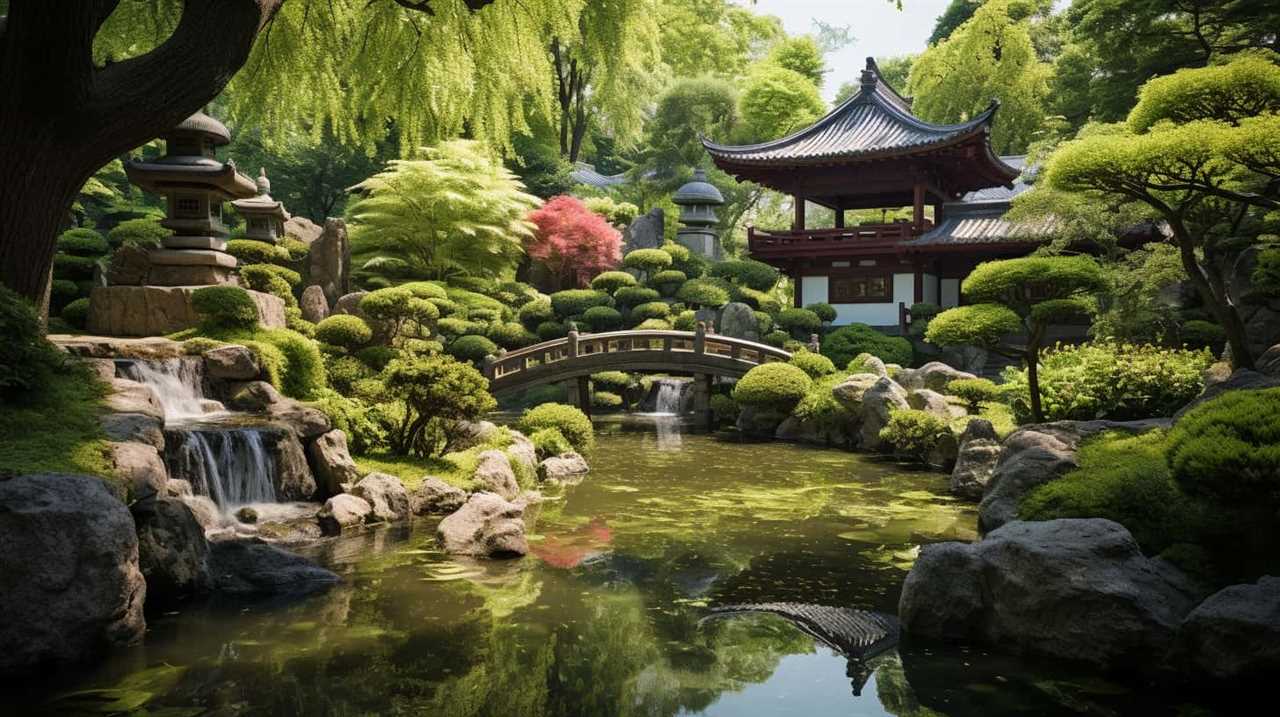
- Matcha contains catechins, which are antioxidants that have been shown to reduce inflammation in the body.
- The high levels of L-theanine in matcha have been found to promote relaxation and reduce stress, which can contribute to a calmer digestive system.
- Matcha has alkalizing properties, which may help to neutralize excess stomach acid and alleviate symptoms of acid reflux.
- The natural compounds in matcha, such as chlorophyll and polyphenols, have been associated with improved digestion and gut health.
- Matcha is often consumed as a tea, which can help to increase hydration and promote proper digestion.
While these potential benefits are promising, it’s important to note that matcha may not work the same way for everyone. It’s always best to consult with a healthcare professional before incorporating matcha into your diet, especially if you have any pre-existing conditions or are taking medications.
In the next section, we’ll explore the potential drawbacks of matcha for acid reflux, including potential risks and long-term effects.
Potential Drawbacks of Matcha for Acid Reflux
When it comes to the potential drawbacks of matcha for acid reflux, there’s some evidence to suggest that matcha may worsen heartburn symptoms in certain individuals.
Matcha contains caffeine, which can relax the lower esophageal sphincter (LES) and allow stomach acid to flow back into the esophagus.
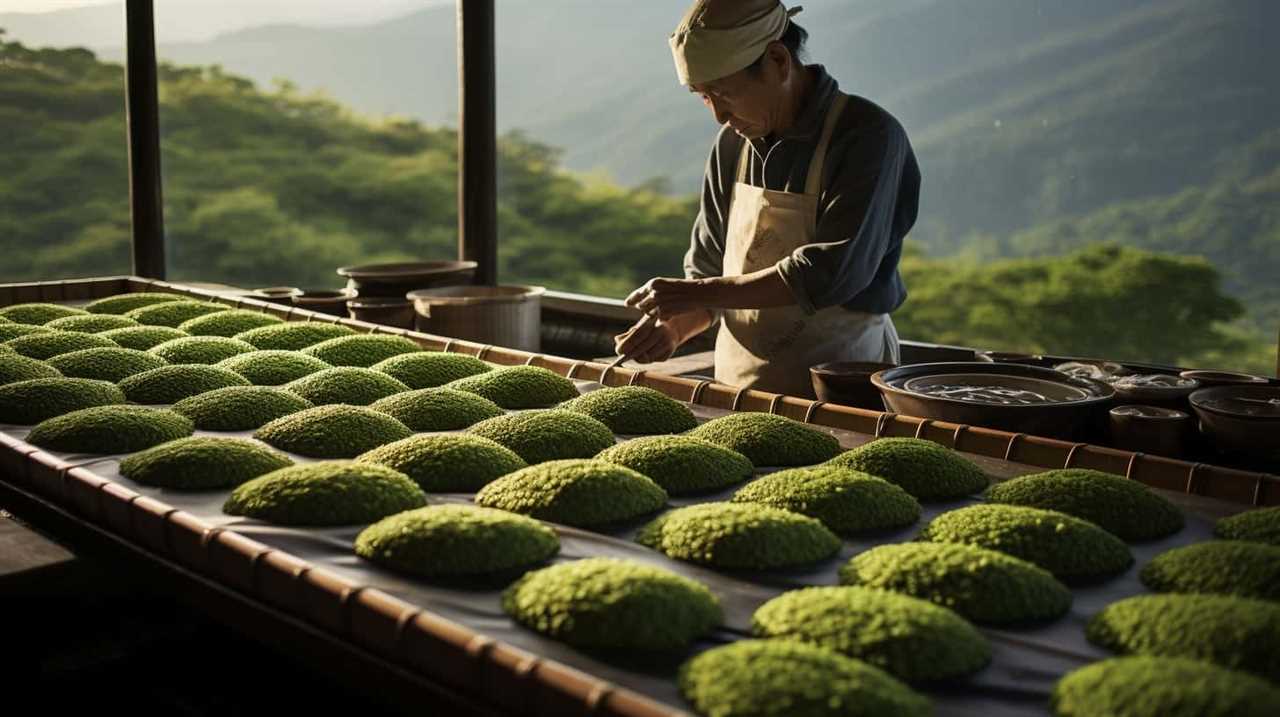
Additionally, matcha is highly acidic, which can further aggravate acid reflux symptoms.
Matcha and Heartburn
How can matcha contribute to heartburn for individuals with acid reflux?
- Matcha contains caffeine, which can relax the lower esophageal sphincter (LES), allowing stomach acid to flow back up into the esophagus.
- The high levels of catechins in matcha can stimulate the production of stomach acid, leading to heartburn.
- Matcha is acidic in nature, which can irritate the lining of the esophagus and trigger heartburn symptoms.
- Consuming matcha on an empty stomach can increase the likelihood of experiencing heartburn.
- Some individuals may have a sensitivity or intolerance to matcha, which can exacerbate acid reflux symptoms.
It is important for individuals with acid reflux to be aware of these potential drawbacks of consuming matcha. It may be helpful to moderate intake, consume matcha with food, or switch to a low-acid alternative to support digestive health and minimize the risk of heartburn.
Acid Reflux Worsened?
To continue discussing the potential drawbacks of matcha for individuals with acid reflux, we will delve into the ways in which matcha can worsen symptoms of acid reflux. While matcha has many health benefits, it may not be suitable for everyone, especially those who suffer from acid reflux. Matcha contains caffeine, which is known to relax the lower esophageal sphincter (LES), a muscle that helps keep stomach acid from flowing back into the esophagus. When the LES is relaxed, it can allow stomach acid to rise, leading to heartburn and other symptoms of acid reflux.

In addition to caffeine, matcha also contains high levels of tannins, which are compounds that can increase stomach acid production and irritate the lining of the esophagus. This can further exacerbate symptoms of acid reflux. It is important to note that different individuals may have varying sensitivities to matcha and its effects on acid reflux. Some people may be able to tolerate matcha without experiencing any negative effects, while others may find that it worsens their symptoms.
To better understand the potential drawbacks of matcha for acid reflux, let’s take a closer look at the acid reflux triggers and natural remedies for acid reflux in the table below:
| Acid Reflux Triggers | Natural Remedies for Acid Reflux |
|---|---|
| Spicy foods | Ginger tea |
| Citrus fruits | Apple cider vinegar |
| Tomatoes | Aloe vera juice |
| Chocolate | Chamomile tea |
| Carbonated drinks | Slippery elm |
It is always best to consult with a healthcare professional before making any changes to your diet, especially if you suffer from acid reflux. They can provide personalized advice and guidance based on your individual needs and medical history.
Tips for Consuming Matcha With Acid Reflux
As matcha enthusiasts with acid reflux, we’ve found strategies to enjoy this vibrant green tea without triggering discomfort. Managing acid reflux symptoms while consuming matcha requires some adjustments in matcha preparation and consumption habits. Here are some tips to help you enjoy matcha without worsening your acid reflux:

- Opt for high-quality matcha: Choose ceremonial-grade matcha, which is made from the youngest and most tender tea leaves. This type of matcha is smoother and less likely to cause irritation.
- Use warm water: Instead of using hot water, which can stimulate acid production, use warm water to prepare your matcha. This helps to reduce the risk of acid reflux.
- Limit the amount: Start with a small amount of matcha and gradually increase the serving size if you don’t experience any discomfort. This allows you to find your tolerance level.
- Drink matcha with food: Consuming matcha with a meal can help to reduce the impact on your digestive system. It also slows down the absorption of caffeine, which may help to prevent acid reflux.
- Listen to your body: Pay attention to your body’s response to matcha. If you notice any symptoms of acid reflux, such as heartburn or regurgitation, it may be best to avoid matcha or consume it in moderation.
Other Considerations for Acid Reflux Sufferers
When managing acid reflux, it’s important for sufferers to consider other factors that may contribute to their symptoms. Besides avoiding trigger foods and beverages, there are several other strategies that can help manage reflux triggers and provide natural remedies for acid reflux.
Firstly, maintaining a healthy weight is crucial. Excess weight can put pressure on the stomach, causing acid to flow back into the esophagus. Regular exercise and a balanced diet can aid in weight management and reduce the severity of acid reflux symptoms.
Secondly, it’s vital to eat smaller, more frequent meals instead of large, heavy meals. This helps prevent overeating and puts less pressure on the stomach, reducing the likelihood of acid reflux episodes.
Additionally, practicing good posture during and after meals can make a difference. Slouching or lying down immediately after eating can increase the risk of acid reflux. Sitting up straight and remaining upright for at least two hours after eating can help gravity keep stomach acid down.
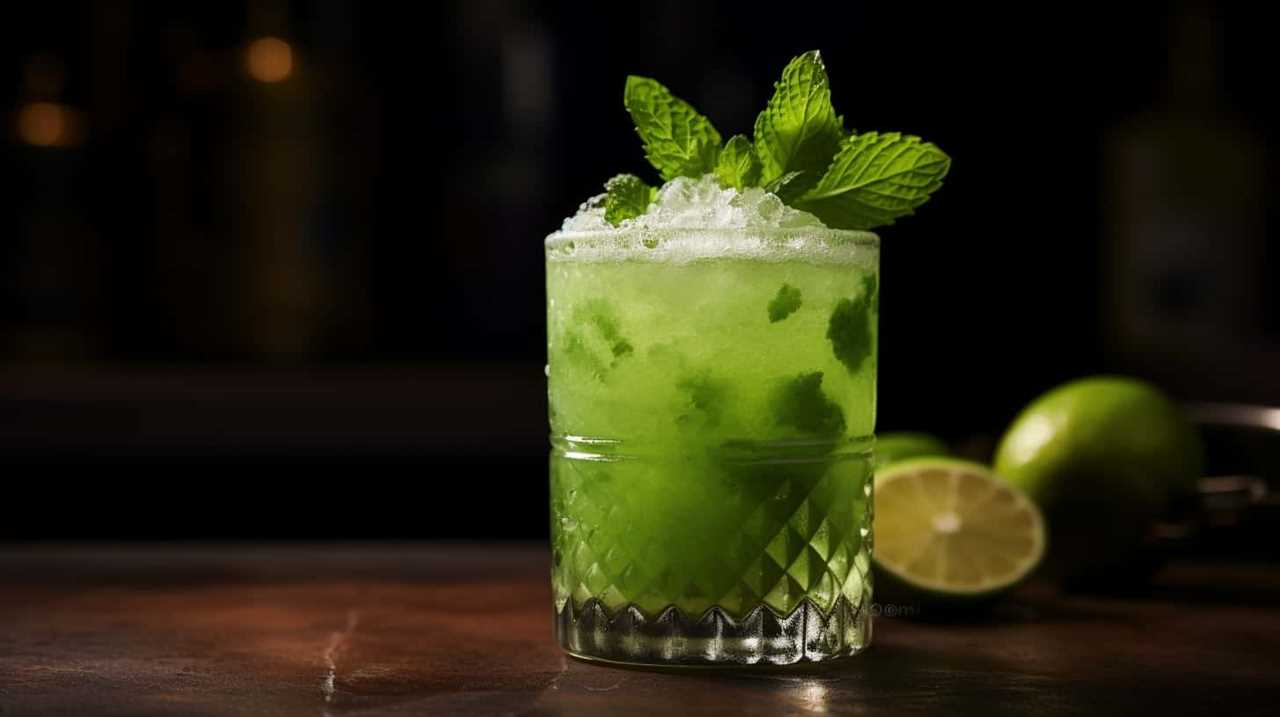
Lastly, avoiding tight-fitting clothing around the waist and stomach can alleviate pressure on the abdomen and reduce acid reflux symptoms.
By managing reflux triggers and adopting these natural remedies, acid reflux sufferers can find relief and improve their overall quality of life.
It’s important to consult with a healthcare professional for personalized advice and guidance.
Alternative Beverages for Acid Reflux
We enjoy exploring alternative beverages that can be beneficial for managing acid reflux symptoms. When it comes to managing acidity levels, there are several alternative beverages that can be considered:
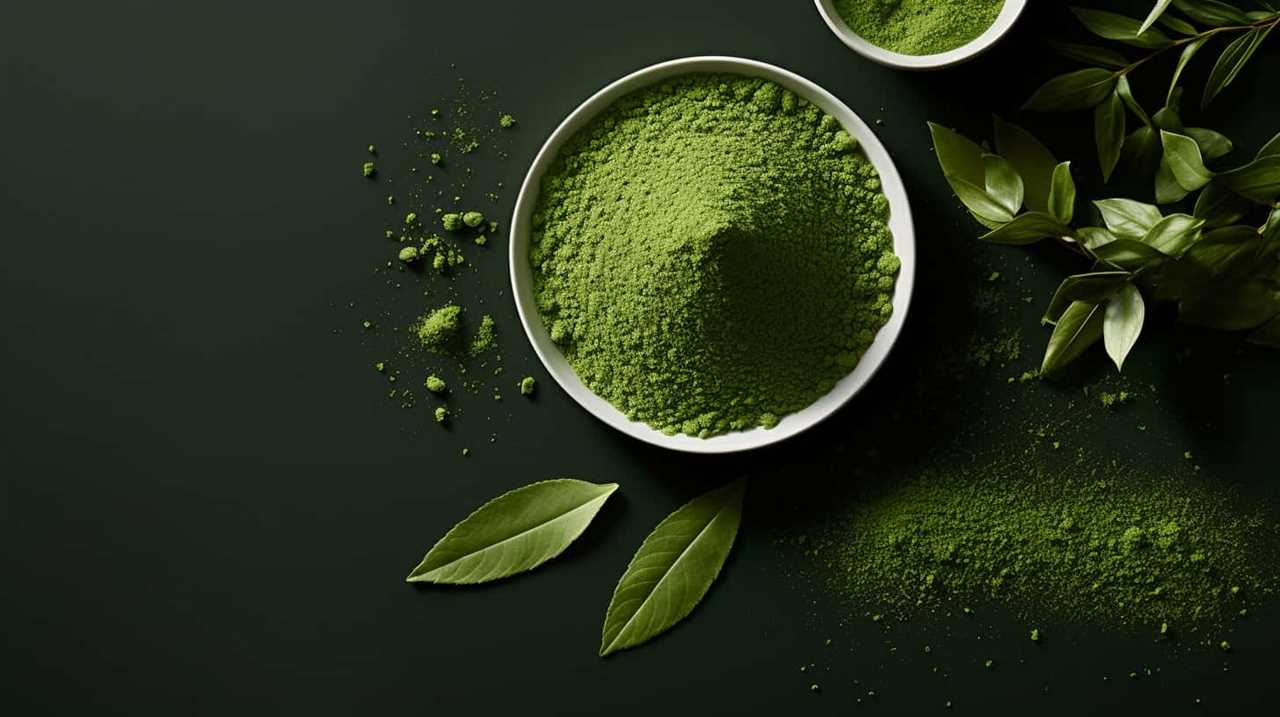
- Herbal tea: Chamomile, ginger, and licorice root teas have been shown to have soothing effects on the digestive system and can help reduce acid reflux symptoms.
- Aloe vera juice: Aloe vera has anti-inflammatory properties that can help soothe the lining of the esophagus and reduce acid reflux symptoms.
- Coconut water: Coconut water is alkaline in nature, which can help neutralize stomach acid and reduce the symptoms of acid reflux.
- Almond milk: Almond milk is a great alternative to dairy milk for those suffering from acid reflux. It’s low in fat and can help soothe the esophagus.
- Green smoothies: Blending together fruits and vegetables like spinach, kale, and cucumber can help alkalize the body and reduce acidity levels.
These alternative beverages can provide relief from acid reflux symptoms and help manage acidity levels.
Now, let’s delve into expert opinions on matcha and its effects on acid reflux.
Expert Opinions on Matcha and Acid Reflux
Experts have differing opinions on the impact of matcha on acid reflux. While some experts believe that matcha can worsen acid reflux symptoms due to its high caffeine content and acidic nature, others argue that matcha may actually be beneficial for individuals with acid reflux.
Research findings on the topic are limited, making it difficult to draw definitive conclusions. However, a study published in the Journal of Gastroenterology and Hepatology suggests that the catechins found in matcha may have a protective effect on the gastric mucosa, potentially reducing the risk of acid reflux.

On the other hand, some experts caution against consuming matcha for those with acid reflux, as it contains caffeine and can be acidic. Caffeine is known to relax the lower esophageal sphincter, allowing stomach acid to flow back into the esophagus, leading to acid reflux symptoms.
It is important to note that individual experiences with matcha and acid reflux may vary. It’s recommended to consult with a healthcare professional or a registered dietitian who can provide personalized advice based on your specific condition and needs.
Final Thoughts: Is Matcha Bad for Acid Reflux?
In our final assessment, we find that matcha’s impact on acid reflux varies and further research is needed to determine its overall effects. While some studies suggest that matcha may have beneficial effects on digestion and gut health, others indicate that it could potentially exacerbate symptoms of acid reflux.
Here are some key points to consider:
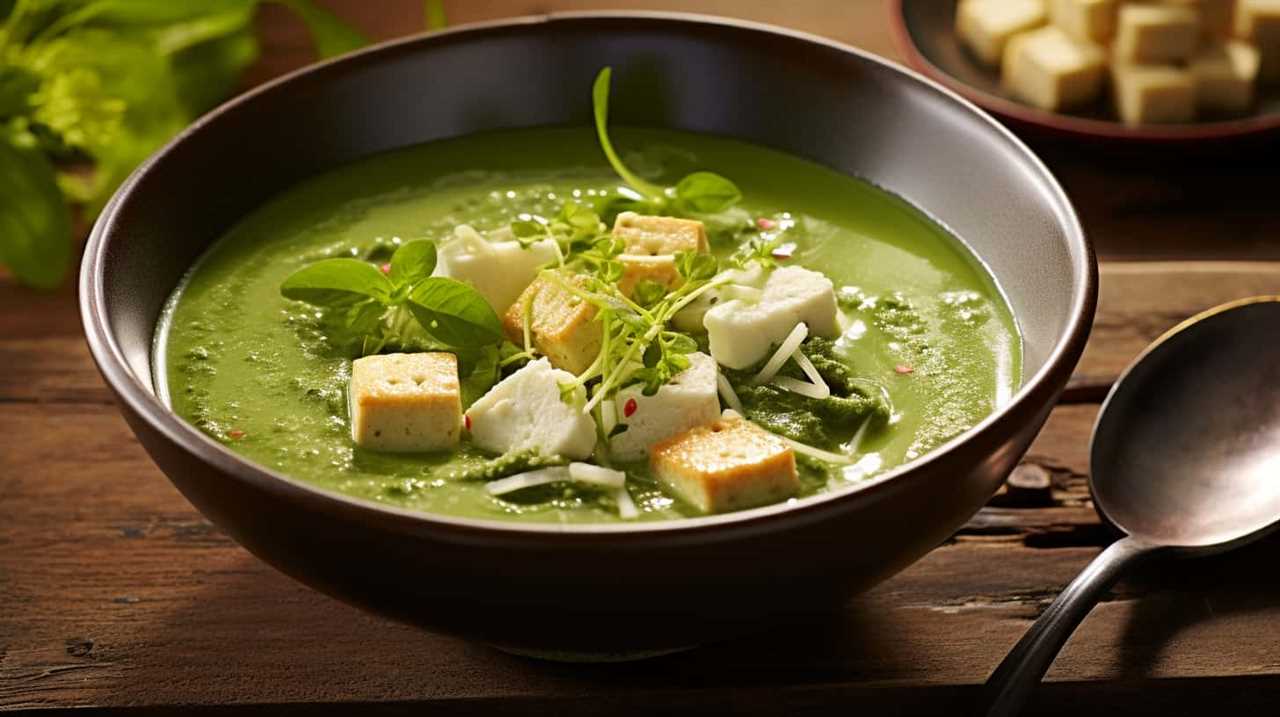
- Potential benefits: Matcha contains antioxidants that may help reduce inflammation in the digestive tract, promoting better gut health.
- Caffeine content: Matcha contains caffeine, which can relax the lower esophageal sphincter and contribute to acid reflux symptoms.
- Individual sensitivity: Each person’s reaction to matcha may differ, so it’s important to pay attention to your own body’s response.
- Preparation methods: The brewing process and additives can affect how matcha interacts with the digestive system. Some people may find that certain preparations are more or less likely to trigger acid reflux.
- Consultation with a healthcare professional: If you have acid reflux or other digestive issues, it’s always a good idea to consult with a healthcare professional for personalized advice.
Frequently Asked Questions
Can Matcha Worsen Acid Reflux Symptoms?
Matcha may exacerbate acid reflux symptoms due to its high caffeine content and potential for increasing stomach acid production. However, individual tolerance may vary, and incorporating matcha into a balanced diet may still promote overall digestive health.
What Are the Potential Benefits of Matcha for Acid Reflux Sufferers?
The potential benefits of matcha for acid reflux sufferers include its high antioxidant content and potential anti-inflammatory properties. However, it’s important to understand potential risks and follow best practices to ensure it doesn’t worsen symptoms.
Are There Any Potential Drawbacks of Consuming Matcha for Individuals With Acid Reflux?
Consuming matcha can have potential drawbacks for those with acid reflux. Matcha may increase stomach acidity, exacerbating symptoms. It is important to consult with a healthcare professional to determine if matcha is suitable for your digestive health.
Are There Any Tips for Consuming Matcha for Individuals With Acid Reflux?
When it comes to managing acid reflux symptoms with matcha, there are a few tips that can help. However, it’s worth noting that there are potential risks associated with consuming matcha for acid reflux.
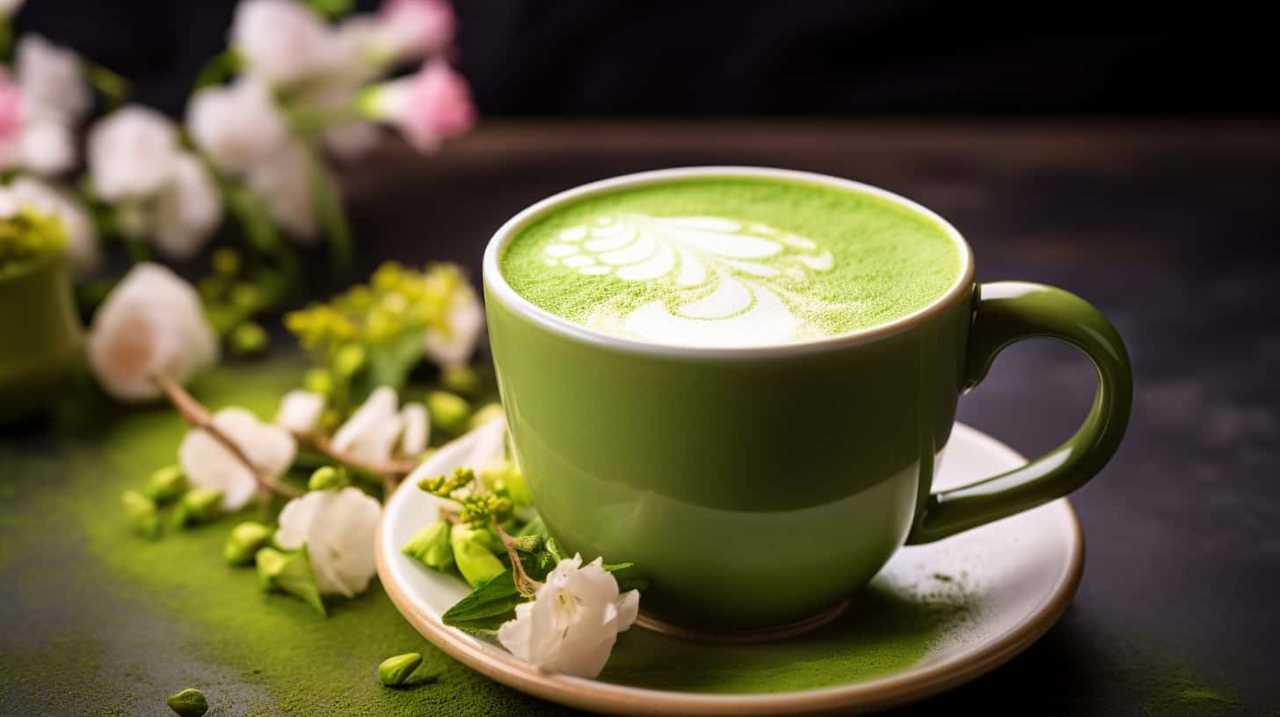
What Are Some Alternative Beverages That Acid Reflux Sufferers Can Consider?
Herbal teas provide relief for acid reflux sufferers. Non-caffeinated alternatives like chamomile and ginger tea can soothe the digestive system. These options promote wellness and comfort, making them excellent choices for those with acid reflux.
Conclusion
In conclusion, while matcha does contain caffeine which can potentially aggravate acid reflux symptoms, it isn’t necessarily bad for acid reflux sufferers. In fact, matcha has been found to have beneficial components such as catechins that may help reduce inflammation and promote digestive health.
According to a study published in the Journal of Gastroenterology and Hepatology, consuming green tea, including matcha, was associated with a 37% reduced risk of developing acid reflux symptoms.
Therefore, moderate consumption of matcha may be a suitable choice for individuals with acid reflux.
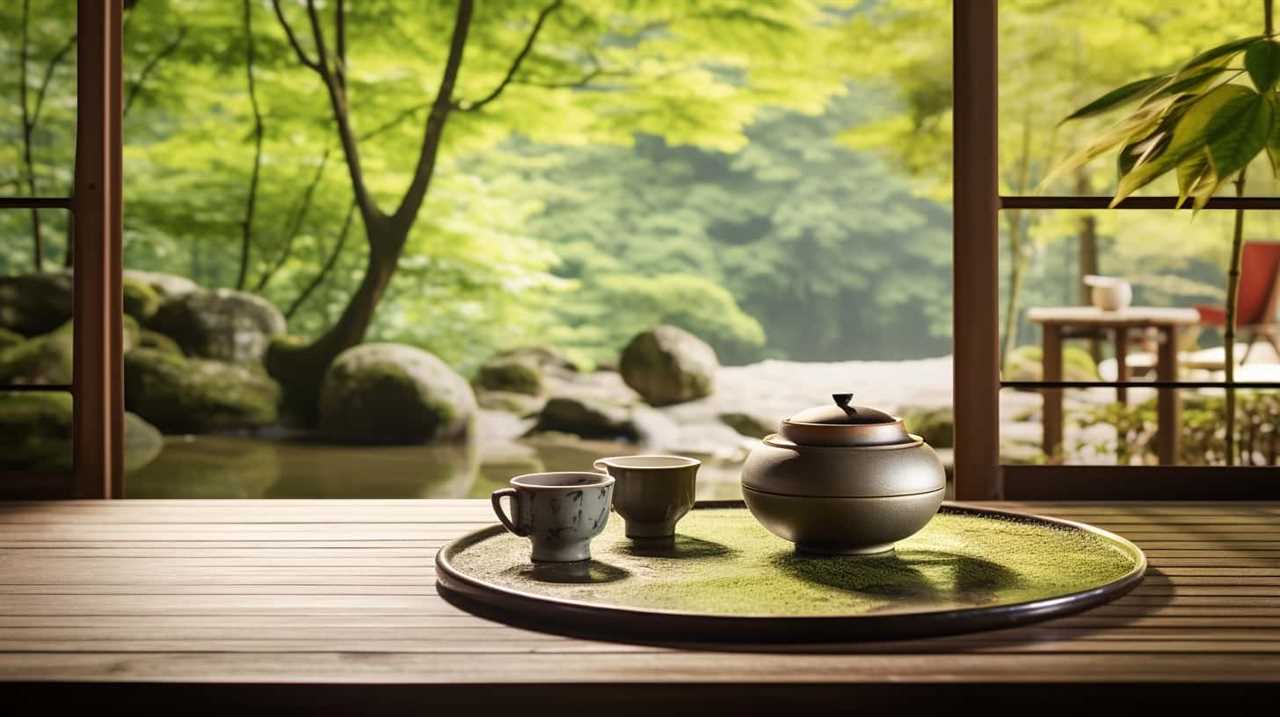
Justin is a seasoned author, coffee and tea enthusiast, and an essential member of the Cappuccino Oracle team. With a keen appreciation for the complexities of coffee, coffee alternatives, and tea, Justin has dedicated his professional career to exploring these realms and sharing his insights with readers worldwide.
Justin’s immersion in the world of coffee, coffee alternatives, and tea began at a young age, kindling a passion that extended beyond mere consumption. This love for these beverages led him to combine his talent for writing with his devotion to coffee and tea, bringing him to Cappuccino Oracle as a dedicated author.
Matcha
Unveiling The Mysteries Of Matcha: Insights On Its Origins, Production, And Quality

Have you ever been curious about the mysteries behind the rich and natural flavors of matcha? If so, get ready to join me on an adventure as we uncover the secrets of matcha, delving into its origins, production, and quality.
As a lover of all things tea, I have delved deep into the world of matcha, immersing myself in its rich history and intricate production process. From the shade-grown tea leaves to the meticulous grinding technique, every step is a labor of love that culminates in the velvety smooth powder we know as matcha.
Join me as we unravel the secrets behind this ancient Japanese tradition and discover why quality is key when indulging in this verdant elixir. We’ll explore the nuances of flavor, the importance of sourcing, and even delve into the fascinating world of other tea varieties.
So grab a cup, sit back, and let’s dive into the captivating world of matcha.
Key Takeaways
- Matcha tea is made from powdered green tea leaves and has a long and labor-intensive production process.
- Premium matcha is made from the first harvest in early spring, using the top 3 sprouts of the tea plant and ground tencha leaves.
- Cheaper matchas may skip some steps in the production process and are more suitable for matcha lattes.
- High-quality matcha is recommended for sparing consumption, as it has a smoother flavor and more health benefits compared to cheaper matchas.
What is matcha?
I’ve learned that matcha is a powdered green tea made from special tea leaves that are shaded before harvest, and it has a long and labor-intensive production process.
There are different types of matcha available, but the premium matcha is made from the first harvest in early spring, using only the top 3 sprouts of the tea plant. The leaves are then steamed, dried, and have their stems removed before being ground into a fine powder using a specialized mill made of granite.
It’s important to note that high-quality matcha is recommended for sparing consumption, as it has a complex production process that results in a smooth flavor. Matcha also offers various health benefits, such as being rich in antioxidants, boosting metabolism, and improving mental alertness.
Production process
The matcha production process involves shading the tea leaves before harvest and selecting the top three sprouts of the tea plant for premium matcha. Shading is a technique used to enhance the flavor and quality of the tea leaves. By covering the tea plants with shade, the leaves produce more chlorophyll and amino acids, resulting in a vibrant green color and a rich, umami taste.
After the shading period, only the top three sprouts of the tea plant are carefully handpicked for premium matcha. These selected leaves, known as tencha leaves, are then steamed, dried, and have their stems removed.
Finally, the tencha leaves are ground into a fine powder using a specialized granite mill. This process results in the smooth and concentrated matcha powder that we enjoy.
Quality and consumption
Let me tell you, indulging in high-quality matcha is like sipping a vibrant green elixir that awakens your taste buds and nourishes your body with its rich flavor and numerous health benefits. Matcha’s health benefits are truly remarkable. Packed with antioxidants, vitamins, and minerals, matcha is known to boost metabolism, enhance focus and concentration, and strengthen the immune system.
But not all matcha is created equal. Different grades of matcha exist, ranging from ceremonial grade to culinary grade. Ceremonial grade matcha is made from the highest quality tencha leaves and has a smooth, vibrant green color and a delicate, umami flavor. It is best enjoyed on its own, whisked with hot water.
On the other hand, culinary grade matcha is more affordable and is suitable for making matcha lattes, smoothies, and baked goods. Although it may have a slightly bitter taste and a duller color, it still provides health benefits.
So, whether you choose to indulge in high-quality ceremonial grade matcha or opt for the more affordable culinary grade, incorporating matcha into your routine is a delicious way to reap its health benefits.
Frequently Asked Questions
What are some popular ways to enjoy matcha besides drinking it as tea?
Besides drinking matcha as tea, some popular ways to enjoy it include indulging in matcha desserts like matcha ice cream, matcha cake, and matcha cookies. Additionally, matcha smoothies are a refreshing and healthy option.
Are there any specific health benefits associated with consuming matcha?
I’m no expert, but matcha is said to have potential health benefits. Some claim it can aid in weight loss due to its high antioxidant content and metabolism-boosting properties. However, more research is needed to confirm these claims.
How does the quality of matcha affect its flavor and overall experience?
The quality of matcha directly affects its flavor and overall experience. Higher quality matcha, made from carefully selected leaves and processed with precision, offers a smoother and more vibrant flavor, while lower quality matcha may have a less appealing taste and color.
Can matcha be used in cooking or baking?
"Where there’s matcha, there’s a way! Matcha can be used in a variety of cooking and baking recipes, adding a vibrant green color and a unique earthy flavor to dishes like matcha desserts."
Are there any specific tips or techniques for properly preparing matcha tea at home?
To properly prepare matcha tea at home, start by sifting the matcha powder to remove any clumps. Then, choose water at around 175°F to 180°F for the best flavor. Gradually add water to the matcha and whisk in a "W" or "M" motion until frothy. Enjoy!
Conclusion
In conclusion, matcha tea is not just a beverage, but a rich and fascinating tradition that has evolved over centuries.
From its origins in Japan to its intricate production process, matcha is a labor of love.
The quality of matcha is crucial, as the steps taken in its production directly impact its flavor and aroma.
Whether you’re a matcha connoisseur or a beginner, there is a matcha tea out there for you.
So, why not indulge in a cup of this vibrant green elixir and experience the magic of matcha for yourself? It’s a journey worth embarking on!
Arf, an author and an innovative enthusiast of coffee, coffee alternatives, and tea, plays a crucial role as a contributor to the esteemed Cappuccino Oracle platform. Renowned for his curiosity and passion for these captivating beverages, Arf has carved out a unique space for himself in the world of exploration and writing. He realized that coffee, coffee alternatives, and tea are not mere drinks to keep one awake, but universes of flavors and stories waiting to be explored.
Arf’s articles for Cappuccino Oracle blend meticulous research with personal experiences, providing readers with an in-depth understanding of various types of coffee, coffee alternatives, and tea, along with their unique characteristics, cultures, and histories. His honest reviews and engaging narratives guide readers on their own journeys, helping them discover their preferences and find their perfect brew.
Matcha
Unveiling The Truth Behind Starbucks’ Matcha: A Disappointing Blend

Being a lover of tea, I was eager to sample Starbucks’ matcha beverages, anticipating a flavorful and genuine taste. However, to my dismay, I found that it was a subpar mixture of inexpensive green tea powder and an excessive amount of sugar. This was a stark contrast to the customary matcha experience that I had grown accustomed to.
The use of low-quality matcha by Starbucks is driven by the need for mass production and a consistent taste across all locations. But in this pursuit, they have sacrificed the true essence of matcha. Authentic matcha production involves meticulous steps to ensure a high-quality and flavorful product, steps that Starbucks seems to skip.
The result is a matcha latte packed with 32 grams of sugar, equivalent to a can of soda, and a whopping 240 calories. It’s time to unveil the truth behind Starbucks’ matcha and explore better options for a truly satisfying tea experience.
Key Takeaways
- Starbucks uses a cheap green tea powder for their matcha drinks, which may not even be considered matcha.
- The cheap matcha powder is mixed with a lot of sugar, negating the health benefits and undermining the quality of the tea.
- Starbucks’ matcha latte contains a high amount of sugar, similar to a can of soda, and has a significant number of calories.
- To have a better matcha experience, it is recommended to explore premium, first harvest matcha made by talented farmers in Japan and to try different matcha options to find preferred taste.
What is Starbucks Matcha?
Starbucks Matcha is a cheap green tea powder mixed with a high amount of sugar, which not only undermines the health benefits of matcha but also fails to deliver the natural, great-tasting flavor of authentic matcha tea.
The ingredients used in Starbucks matcha include low-quality green tea powder that is likely produced on a large scale. Unlike traditional matcha production methods, Starbucks skips certain steps to save time and money. These steps, such as shading the tea plants to reduce bitterness and selecting the top leaves for their flavor and nutrients, are crucial in creating high-quality matcha.
Instead, Starbucks opts for a blend of cheap green tea powder mixed with sugar, resulting in a dull and bitter flavor. This disappointing blend of ingredients does not live up to the standards of true matcha tea.
Quality vs. Cheap Matcha
Indulging in high-quality matcha is like savoring a delicate melody that dances on your taste buds, while settling for cheap matcha is akin to a discordant symphony that leaves a bitter aftertaste. When it comes to matcha, quality matters. Traditional matcha production is an art that requires time, patience, and attention to detail. The importance of shading the tea plants, selecting the top leaves, and using a stone mill to grind the leaves into a fine powder cannot be overstated. These steps not only enhance the flavor but also preserve the health benefits of matcha. High-quality matcha is rich in antioxidants, boosts metabolism, and promotes a sense of calm. On the other hand, cheap matcha often lacks these qualities as it skips crucial steps and is mixed with sugar and other additives. Don’t settle for a subpar matcha experience; choose high-quality matcha for its exceptional taste and health benefits.
| Traditional Matcha Production |
|---|
| Shading the tea plants |
| Selecting the top leaves |
| Grinding with a stone mill |
The importance of traditional matcha production cannot be overstated. These steps not only enhance the flavor but also preserve the health benefits of matcha. High-quality matcha is rich in antioxidants, boosts metabolism, and promotes a sense of calm. On the other hand, cheap matcha often lacks these qualities as it skips crucial steps and is mixed with sugar and other additives. Don’t settle for a subpar matcha experience; choose high-quality matcha for its exceptional taste and health benefits.
Recommendations for Better Matcha
Exploring different matcha options can lead to a better matcha experience. When it comes to matcha, not all options are created equal. While Starbucks may offer a convenient matcha latte, there are alternative options that provide a more authentic and higher quality experience.
Premium matcha, specifically first harvest matcha, is made by talented farmers in Japan and can be enjoyed plain, without the need for excessive sugar or additives. By choosing premium matcha, you can reap the full benefits that matcha has to offer, such as its high antioxidant content and potential health benefits.
Additionally, exploring different types of matcha, such as Japanese black tea, can expand your taste palate and introduce you to new and exciting flavors. So, why settle for a disappointing blend when there are better matcha options out there waiting to be explored?
Frequently Asked Questions
How is Starbucks matcha different from traditional matcha?
Starbucks matcha differs from traditional matcha in terms of quality and taste. One interesting statistic is that Starbucks’ matcha latte contains 32 grams of sugar, similar to a can of soda, which undermines the health benefits of matcha.
What are the health benefits of matcha and how do they differ between Starbucks matcha and premium matcha?
The health benefits of matcha include high levels of antioxidants, increased energy, and improved focus. However, Starbucks matcha quality is compromised due to the use of cheap powder mixed with sugar, negating these benefits.
Can you customize the sweetness level of Starbucks matcha drinks?
Yes, you can customize the sweetness level of Starbucks matcha drinks. They offer popular matcha drink variations like matcha latte and matcha frappuccino, allowing customers to choose the amount of sweetener they prefer.
Are there any alternative options for matcha drinks at Starbucks?
Yes, there are alternative options for matcha drinks at Starbucks. However, it’s important to note that the taste may not be comparable to traditional matcha. Exploring different matcha options and Japanese black tea can provide a better experience.
What are the steps involved in producing high-quality matcha and how does Starbucks’ matcha production differ?
Starbucks’ matcha production process differs from traditional matcha production in Japan. High-quality matcha involves shading the tea plants, selecting the top leaves, steaming, drying, and grinding them. However, Starbucks skips these steps, resulting in a lower quality and less authentic matcha experience.
Conclusion
In conclusion, after delving into the truth behind Starbucks’ matcha, it’s clear that their blend falls short of expectations. The use of cheap green tea powder mixed with excessive sugar dilutes any potential health benefits and fails to deliver an authentic matcha experience.
To truly enjoy the rich and flavorful taste of matcha, it’s recommended to explore premium, first harvest options crafted by skilled Japanese farmers. Don’t settle for subpar matcha; treat yourself to a tea experience that’ll leave your taste buds dancing with delight.
Arf, an author and an innovative enthusiast of coffee, coffee alternatives, and tea, plays a crucial role as a contributor to the esteemed Cappuccino Oracle platform. Renowned for his curiosity and passion for these captivating beverages, Arf has carved out a unique space for himself in the world of exploration and writing. He realized that coffee, coffee alternatives, and tea are not mere drinks to keep one awake, but universes of flavors and stories waiting to be explored.
Arf’s articles for Cappuccino Oracle blend meticulous research with personal experiences, providing readers with an in-depth understanding of various types of coffee, coffee alternatives, and tea, along with their unique characteristics, cultures, and histories. His honest reviews and engaging narratives guide readers on their own journeys, helping them discover their preferences and find their perfect brew.
Matcha
The Ultimate Guide To Using Chashaku: Your Matcha Essential

Being a lover of matcha, I am aware that the crucial factor in achieving the perfect matcha bowl is the equipment we utilize. When it comes to preparing matcha, there is one tool that is particularly essential: the chashaku.
This bamboo spoon, with its elegant design and precise measurements, is the secret weapon of matcha lovers worldwide. In this ultimate guide, I will take you on a journey through the history and evolution of the chashaku, and show you how to use it like a pro.
From its origins as a metal or ivory scoop to its modern-day incarnation in bamboo, the chashaku has come a long way. With its 48° bend and 18mm length, it effortlessly scoops the perfect amount of matcha from its container.
So grab your chashaku and get ready to elevate your matcha game to new heights. Let’s dive in and discover the wonders of this matcha essential.
Key Takeaways
- Chashaku is a bamboo spoon used to scoop matcha powder in the Japanese tea ceremony and by matcha lovers worldwide.
- Chashaku is one of the three important tea utensils used in the tea ceremony and is about 18mm in length with a 48° bend at the end for scooping.
- Chashaku is made of bamboo to avoid negative reactions with matcha powder and is a great measurement tool for matcha powder.
- Two scoops of chashaku is the standard amount for a bowl of matcha tea, and it is easy to maneuver in matcha tins or natsume due to its small size.
What is Chashaku?
Chashaku is a bamboo spoon used to scoop matcha powder, and it’s one of the three important tea utensils used in the Japanese tea ceremony.
Made from a single piece of bamboo, this elegant tool has a long history dating back to the Muromachi period in Japan. Originally crafted from metal or ivory, chashaku evolved to be made of bamboo due to its natural properties and to avoid any negative reactions with matcha powder.
The design of chashaku is both functional and beautiful, with a length of about 18mm and a 48° bend at the end for easy scooping. There are different styles of chashaku scoops, each with its own unique shape and characteristics. The back of the chashaku has a rough texture, while the face is smooth and sleek.
Whether you’re a matcha lover or a tea ceremony enthusiast, using a chashaku adds a touch of authenticity and tradition to your matcha preparation.
History and Evolution
During the Muromachi period in Japan, the chashaku spoon evolved from being made of metal or ivory to its current bamboo form, which is about 18mm in length and has a 48° bend at the end for easier scooping. The history and evolution of the chashaku is a testament to its significance in Japanese tea ceremonies and its cultural importance in matcha preparation.
| The significance of chashaku in Japanese tea ceremonies | The cultural importance of chashaku in matcha preparation |
|---|---|
| Chashaku is one of the three important tea utensils used in the tea ceremony. | Chashaku is a great measurement tool for matcha powder. |
| Chashaku originated in Japan during the Muromachi period. | Chashaku’s small size allows for easy maneuvering in matcha tins or natsume. |
| Originally made of metal or ivory, chashaku evolved to be made of bamboo. | Chashaku is made from a single piece of bamboo and shaped with a bend for the scoop. |
| Chashaku is made of bamboo to avoid negative reactions with matcha powder. | The back of chashaku has a rough texture, while the face is smooth and sleek. |
The chashaku’s role in Japanese tea ceremonies cannot be understated. It is one of the three essential utensils used in the tea ceremony, alongside the chawan (tea bowl) and chasen (tea whisk). The chashaku’s small size and precise measurement make it the perfect tool for scooping matcha powder. Its evolution from metal or ivory to bamboo shows the cultural importance placed on this utensil. The chashaku’s design, with its gentle bend and smooth face, allows for easy and graceful scooping of matcha. Using the chashaku is not only practical but also a way to honor the centuries-old tradition of matcha preparation.
How to Use Chashaku
To use the chashaku, I simply hold it like a pencil and dip the scoop into the matcha container. Then, I carefully lift the chashaku scoop out and place it over the matcha bowl to dump the powder.
It’s a simple and elegant technique that ensures the perfect amount of matcha every time.
But did you know that there are alternative ways to use the chashaku? Some matcha lovers prefer to use a teaspoon or a regular spoon to scoop their matcha powder. While these alternatives may work in a pinch, they don’t offer the same precision and authenticity as the chashaku.
The chashaku’s unique design and size make it the ideal tool for measuring matcha powder. Plus, using the chashaku adds a traditional touch to the matcha preparation process, enhancing the overall experience.
So why settle for anything less? Embrace the chashaku and elevate your matcha game to the next level.
Frequently Asked Questions
What are the different types of materials used to make chashaku besides bamboo?
There’s something truly magical about the chashaku, the bamboo spoon that gracefully scoops matcha powder. While bamboo is the traditional material, chashaku can also be made from metal or ivory, although these alternatives are less common.
Can chashaku be used to scoop other powders besides matcha?
Yes, chashaku can be used to scoop other powders besides matcha. However, it is primarily designed for scooping matcha powder and is most commonly used in Japanese tea ceremonies. To properly clean and care for a chashaku, it is recommended to wipe it with a dry towel or tissue to avoid water damage. The chashaku is a versatile tool with different uses in the tea ceremony, making it an essential item for matcha lovers.
How long does a chashaku typically last before it needs to be replaced?
A chashaku typically lasts for a long time, but the lifespan can vary depending on the material. Bamboo chashaku is the most common and durable option, while metal or ivory may wear down over time. Proper care involves cleaning with a dry towel or tissue to avoid water damage.
Can chashaku be used with different types of matcha bowls or is it specific to a certain style?
Absolutely! Chashaku can be used with various types of matcha bowls, adapting to different styles. Its small size and unique design make it perfect for scooping matcha powder and adding a touch of elegance to your matcha preparation.
Are there any alternative utensils that can be used in place of chashaku for scooping matcha powder?
Yes, there are alternative utensils for scooping matcha powder, such as a teaspoon or a small spoon. However, using a chashaku has its benefits. Its unique design allows for precise measurements and easy maneuvering in matcha tins.
Conclusion
In conclusion, using chashaku isn’t just a practical way to measure and scoop matcha powder, but it’s also an essential tool for embracing the art and tradition of the Japanese tea ceremony.
While some may argue that using a regular spoon can achieve the same result, chashaku offers a unique experience that connects us to centuries of tea culture. Imagine holding the slender bamboo spoon, feeling the weight of tradition in your hand, and delicately scooping the vibrant green matcha powder.
It’s a sensory journey that brings us closer to the beauty and mindfulness of matcha preparation. So, embrace the chashaku, and let it elevate your matcha experience to new heights.
Arf, an author and an innovative enthusiast of coffee, coffee alternatives, and tea, plays a crucial role as a contributor to the esteemed Cappuccino Oracle platform. Renowned for his curiosity and passion for these captivating beverages, Arf has carved out a unique space for himself in the world of exploration and writing. He realized that coffee, coffee alternatives, and tea are not mere drinks to keep one awake, but universes of flavors and stories waiting to be explored.
Arf’s articles for Cappuccino Oracle blend meticulous research with personal experiences, providing readers with an in-depth understanding of various types of coffee, coffee alternatives, and tea, along with their unique characteristics, cultures, and histories. His honest reviews and engaging narratives guide readers on their own journeys, helping them discover their preferences and find their perfect brew.
-

 Americano4 weeks ago
Americano4 weeks agoHow to Make Americano With Moka Pot
-

 Americano2 weeks ago
Americano2 weeks agoHow to Make Korean Iced Americano
-

 Americano4 weeks ago
Americano4 weeks agoHow to Make Americano With Bialetti
-

 Americano4 weeks ago
Americano4 weeks agoHow to Make Dutch Bros Americano
-

 Americano1 week ago
Americano1 week agoHow to Make an Iced Americano With Nespresso
-

 Americano2 weeks ago
Americano2 weeks agoHow Many Shots of Espresso for 16 Oz Americano
-

 Americano4 weeks ago
Americano4 weeks agoHow to Make a Hazelnut Americano
-

 Turmeric Tea1 week ago
Turmeric Tea1 week agoTurmeric Saffron Tea

















